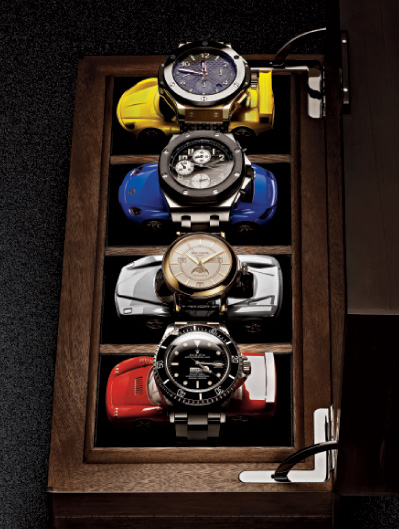Chris Del Gatto

One of the men most responsible for changing the face—and fate—of jewelry today is not a designer or a miner. It’s Chris Del Gatto, the co-founder, chairman, and CEO of the eight-year-old company CIRCA. Del Gatto is a New York City native who, while still in his teens, went to school to become a gemologist. He then apprenticed at a diamond company as a stonecutter before becoming a full-fledged partner. But then Del Gatto got out of the diamond business—at least as a cutter and wholesale supplier. He set to work to understand jewelry’s secondary market on an international level, eventually parlaying his love of stones into a business that publicly buys (anyone can walk in to sell) and privately sells (CIRCA shoppers are by invitation only) pieces from some of the world’s premiere collectors. Now Del Gatto is expanding his business, and among his latest strategies is taking the back inventory of top designers and turning it into revenue. Del Gatto travels the globe during work hours and even on his days off—he owns a polo team and plays the Argentina–Palm Beach–Hamptons circuit. But he still finds time to collect the occasional prize piece for his own budding wristwatch collection.
CHRISTOPHER BOLLEN: What got you interested in jewelry at such a young age?
CHRIS DEL GATTO: I guess what got me going with jewelry is the sense that if a piece is done right, it’s an artwork that you can feel and touch. To this day, when we buy an important stone, if it’s a 20-carat diamond or a fabulous Burma ruby, I have a hard time giving it up—I have to walk around with it in my pocket and feel it. [laughs]
BOLLEN: By the time you were in your late teens, you were already a certified gemologist. Can you spot a fake a mile off?
DEL GATTO: Sure. For the most part. It’s almost hard to describe articulately how you can tell right off the bat. It’s a nose you develop—or really an eye, after seeing so much of the real thing. When it’s in your hand, it just doesn’t feel right; the smell is off.
BOLLEN: So no real expert is ever fooled?
DEL GATTO: There is something called moissanite today, which is much more sophisticated than cubic zirconia. Moissanite has a property called double refraction, which means you really have to have a great eye and look at the facet junctions of the stone. It will have a mirror quality, which is an indication that it’s not a real diamond. You could take moissanite to a hundred jewelers across the country, and 98 of them would buy it as a diamond. But here at CIRCA, we know.
BOLLEN: Why did you get out of the diamond-supply business and start CIRCA?
DEL GATTO: At that time in the diamond business—in the early ’90s—De Beers still very much had a strong hold on diamond mining and distribution worldwide. They controlled 80 percent of the world’s uncut diamonds. When De Beers decided to become a retailer on its own, I knew that the diamond supply would really become interrupted.BOLLEN: A diamond monopoly.
DEL GATTO: Exactly, which it basically already was. I went into the estate-jewelry business because I saw that market as completely fragmented. It was the Wild West of jewelry. So I leaped in and learned the business. I would go around the world and buy at auctions. I used to go to St. Moritz [Switzerland] and Geneva and London at 22 and 23 educating myself. I knew a lot of the major players in the estate world because it overlapped with the diamond industry. People would come to me for advice on diamonds. And then I started to learn about the business of stones. It’s one thing to be able to look at a stone and say, “Yes, this is an 8-carat ruby,” and another to put a price on that8-carat ruby. So it occurred to me that there was a business potential in secondhand jewelry and watches, similar to De Beers. What are the mines of watches and diamonds? The best mine is really the general public: There are probably hundreds of billions of dollars sitting in vaults all over the world. We’re relevant today because we recycle. The big theme in luxury is sustainability. We make it possible for oldjewelry to enter the market again and have a new life.
BOLLEN: Obviously discretion is a big part of your business, but what are some of the more monumental pieces that have come through your doors?
DEL GATTO: We bought a 50-carat antiquecushion-cut diamond we named the CIRCA Cushion. Also, we bought a tiara from one of the royal families in Europe that was owned by Napoleon’s sister.
BOLLEN: I know you have an amazing personal collection of watches. How did you fix on that
obsession?
DEL GATTO: For me, the fun is to have something you’re actually going to wear. It’s fun to have it and look at it, but I want to wear it—something pleasurable that fits.
BOLLEN: You must get a lot of people coming in who think their family jewelry is worth a fortune, and you have to break it to them that it isn’t.
DEL GATTO: Sure. One time a brother and sister came in with what looked like a beautiful Burma ruby. Grandma always told them it was so valuable. It was beautiful, in an art deco mounting. But we were looking at it and could tell right away that it was synthetic.
Photo: A selection of Del Gatto’s watches, from top: Hublot’s big bang, Audemars piguet’s royal oak offshore, Patek Philippe’s t-150 made for Tiffany & Co., and Rolex’s sea-dweller comex edition. Watch box: Alfred Dunhill. Prop Styling: Janine Trott/m.a.p.
Christopher Bollen is Interview’s editor at large.






